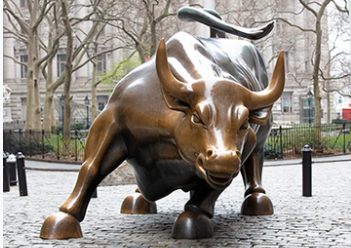
(Photo : wikimedia.org)
- The S&P 500 surpassed the 6,000 mark, fueled by Trump's election victory and potential Republican Congress sweep.
- The Federal Reserve's interest rate cut also supported stocks, leading to the best weekly percentage jump since November 2023.
- The Dow Jones rose above 44,000 for the first time, partly due to a boost from Salesforce.
- Despite positive market performance, shares of Airbnb and Pinterest dropped due to missed profit estimates and disappointing revenue forecast.
The S&P 500 briefly surpassed the 6,000 mark, closing with its biggest weekly percentage gain in a year. This surge was primarily fueled by Donald Trump's election victory and the potential for a Republican Party sweep in Congress, which has sparked expectations for favorable business policies. The Federal Reserve's widely anticipated interest rate cut of 25 basis points on Thursday also played a significant role in supporting stocks this week. The S&P 500 and the Dow Industrials registered their best weekly percentage jump since early November 2023, while the Nasdaq notched its best week in two months and the second-best week of 2024.
Investors were closely monitoring the possibility of a Red Sweep, as Republicans were poised to maintain their narrow lead in the House of Representatives after winning control of the Senate. This political landscape would make it easier for Trump to enact his legislative plans. Expectations for lower corporate taxes and deregulation lifted the Nasdaq to record closing highs for three consecutive sessions. The S&P secured its 50th record close of the year.
Mike Dickson, head of research and quantitative strategies at Horizon Investments in Charlotte, North Carolina, commented on the psychological importance of the 6,000 mark, stating, There's been so many things, so much good news for the market this week as evidenced by the prices. All of that far outweighs whether or not we're on the right or left-hand side of that 6,000 number when the close happens.
Market Performance and Key Drivers
The Dow Jones Industrial Average rose 259.65 points, or 0.59%, to 43,988.99, the S&P 500 gained 22.44 points, or 0.38%, to 5,995.54, and the Nasdaq Composite gained 17.32 points, or 0.09%, to 19,286.78. For the week, the S&P 500 gained 4.66%, the Nasdaq rose 5.74%, and the Dow climbed 4.61%.
The Dow rose above 44,000 for the first time, partly due to a late boost from Salesforce, which climbed 3.59% after Bloomberg reported the software company will hire 1,000 employees to promote its artificial intelligence Agentforce Tool. The S&P 500 and Nasdaq secured their fourth straight session of gains.
Rate-sensitive sectors such as real estate and utilities were the best performing of the 11 major S&P 500 groups as Treasury yields fell for a second straight session after a sharp jump following the election. However, the benchmark 10-year U.S. Treasury note yield remained near a four-month high, and markets have scaled back expectations for the pace of Fed rate cuts in 2025 due to concerns over the incoming administration's proposed tariffs, which are likely to rekindle inflation.
Impact on Small Cap Stocks and Consumer Sentiment
The small cap Russell 2000 also advanced and was up 8.51% for the week, registering its largest weekly percentage gain since April 2020. Domestically concentrated stocks are seen as likely to benefit from easier regulations, lower taxes, and less exposure to import tariffs.
U.S. consumer sentiment rose to a seven-month high in early November, with a measure of households' expectations for the future climbing to the highest in more than three years, led by brightening outlooks among Republicans, according to the University of Michigan's Consumer Sentiment Index.
However, not all news was positive. Airbnb shares dropped 8.66% after the homestay company missed third-quarter profit estimates, while social media company Pinterest tumbled 14% after a disappointing revenue forecast. U.S.-listings of Chinese companies lost ground as the government's latest fiscal support measures once again failed to impress investors. JD.com fell 6.99% and Alibaba lost 5.94%.
* This is a contributed article and this content does not necessarily represent the views of btin.co.in









